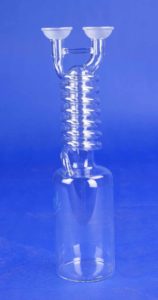Butane Collection for True Boiling Point Distillation – ASTM D2892
 Butane is a component of crude oil that boils well below room temperature. Its low boiling point requires special receivers to prevent loss of butane from the system. The receivers are cooled with dry ice or a cold finger style cooling system.
Butane is a component of crude oil that boils well below room temperature. Its low boiling point requires special receivers to prevent loss of butane from the system. The receivers are cooled with dry ice or a cold finger style cooling system.
There will either be a rise or drop of vapor temperature from the ambient conditions when boil-up is reached. Simply put, if the vapor temperature increases, there is little or no butane in the sample. If the vapor temperature decreases, then butane is in the sample. If the vapor temperature goes below 15 °C, there is a significant amount of butane and it is not able to get past the condenser to the butane trap(s).
If the vapor temperature is above 15 °C after equilibration, the collection of fractions can commence. However, if the vapor temperature is below 15 °C, the condenser temperature needs to be gradually raised from -20 °C until the vapor temperature rises above 15 °C. At that point butane should be able to get past the condenser to the butane traps.
Traditional Butane Traps
Traditional butane traps are operated with two cold traps in series. The first butane trap should contain all of the butane. The second butane trap should be empty and “stand as witness” that no butane has gotten by and escaped to the atmosphere.
It is important to keep the butane traps supplied with fresh dry ice until all the butane is collected. Once the vapor temperature reaches 65 °C all of the available butane has been collected.
Free the butane traps from the dry ice and quickly weigh them. If gas chromatography (GC) analysis is required, quickly take a sample of the butane in a chilled syringe.
Be careful! Butane is very volatile and flammable. The butane trap should be handled in a fume hood one removed from the distillation unit.
Be careful! Use dry ice in a well ventilated area and with a CO2 safety monitor.
Be careful! Never use liquid nitrogen to cool a butane trap. It can condense oxygen which is unstable when in contact with organic compounds. Again, liquid oxygen can be incredibly dangerous!
Consult your safety officer for a comprehensive list of safety precautions.
Automatic Butane Traps
“Cold finger” cooling systems are commonly used to maintain cold traps. They can operate at the temperature of dry ice or lower. While cold fingers add significant upfront cost, they are a great convenience and a good option for locations where dry ice is not available.
Comments are closed, but trackbacks and pingbacks are open.